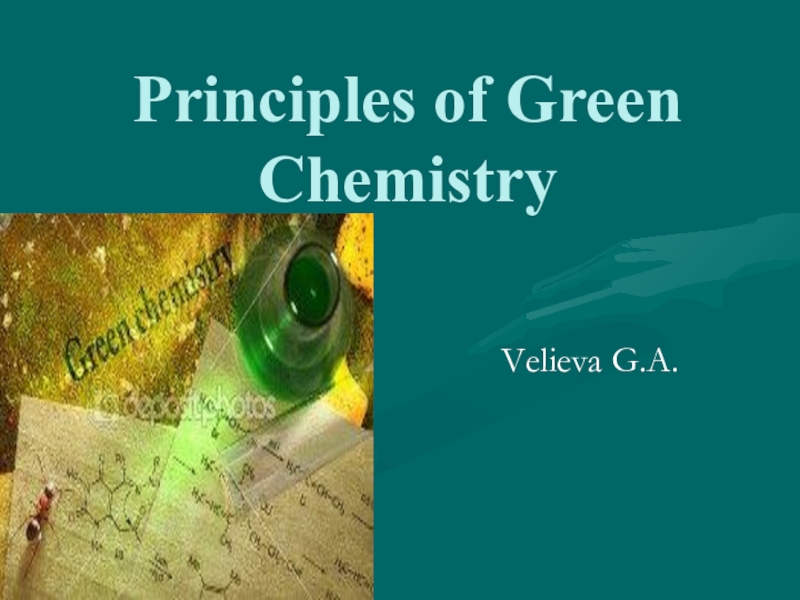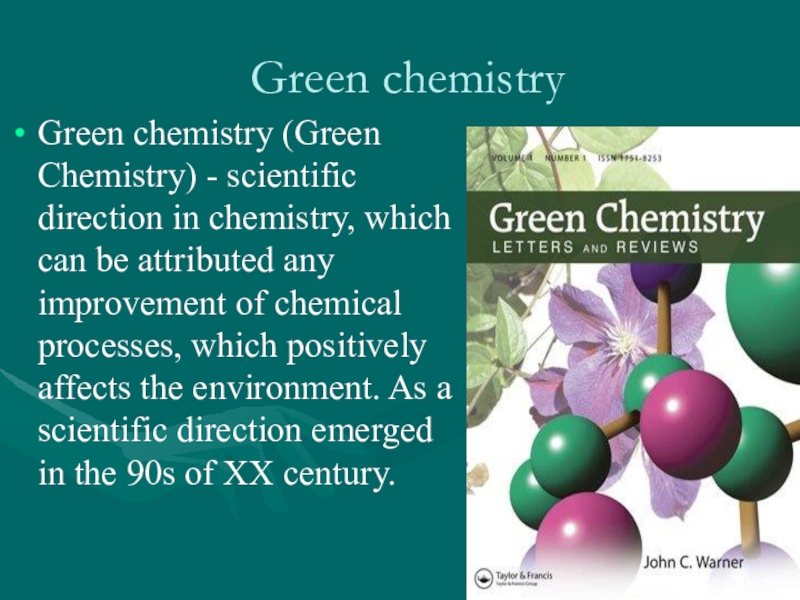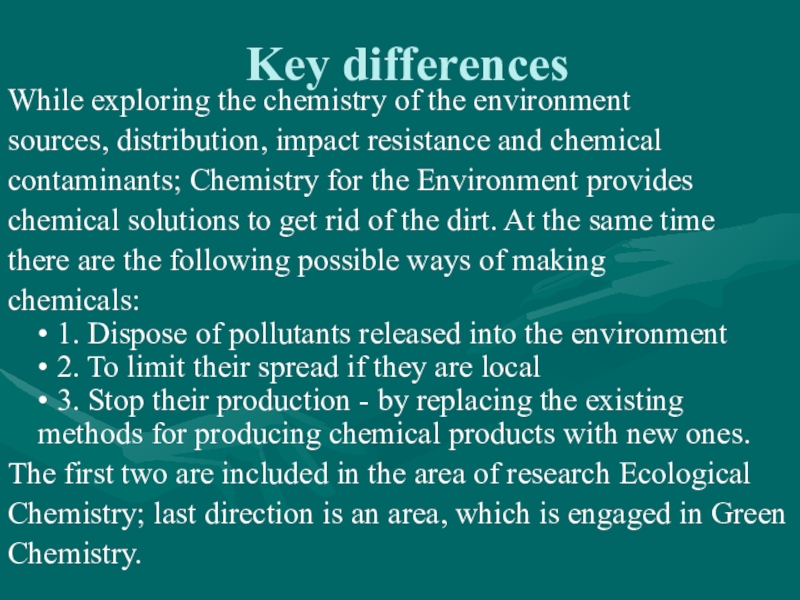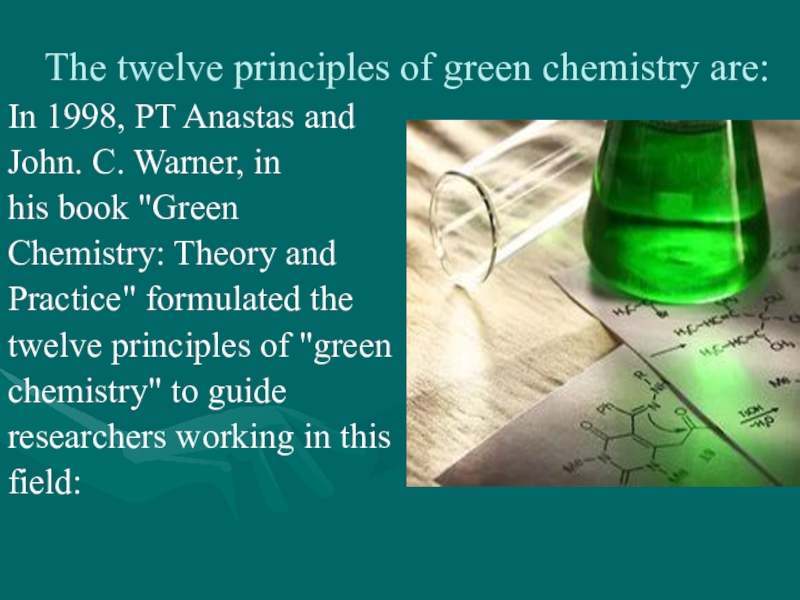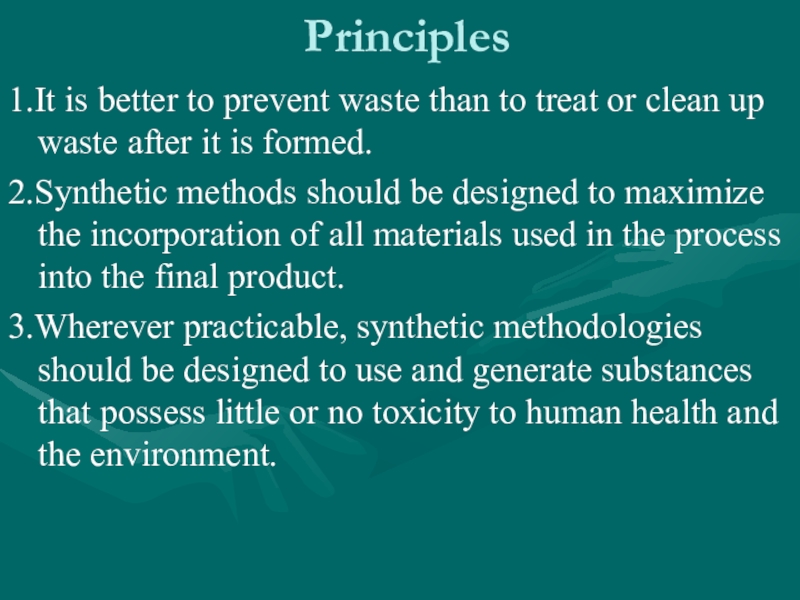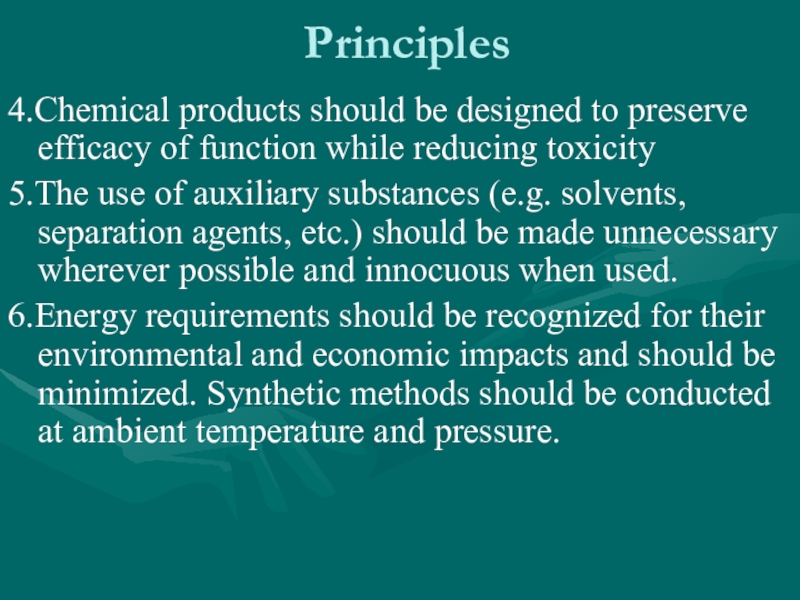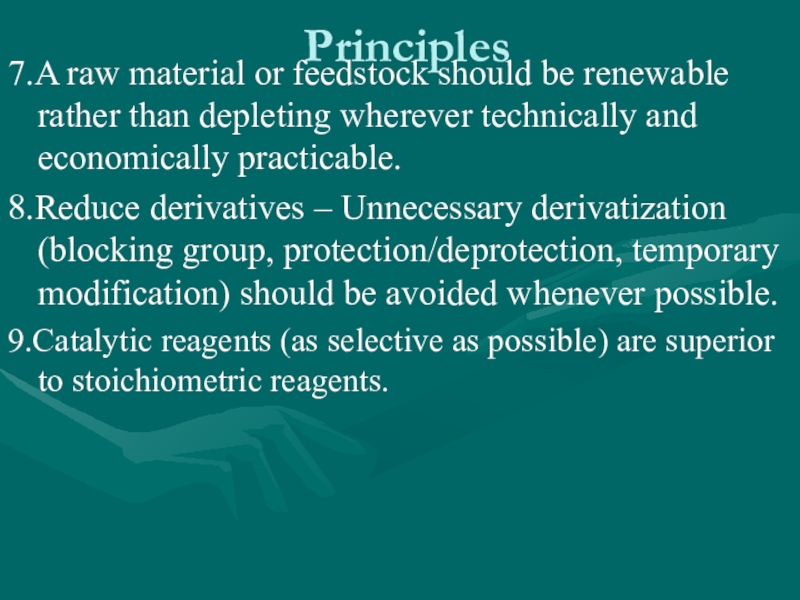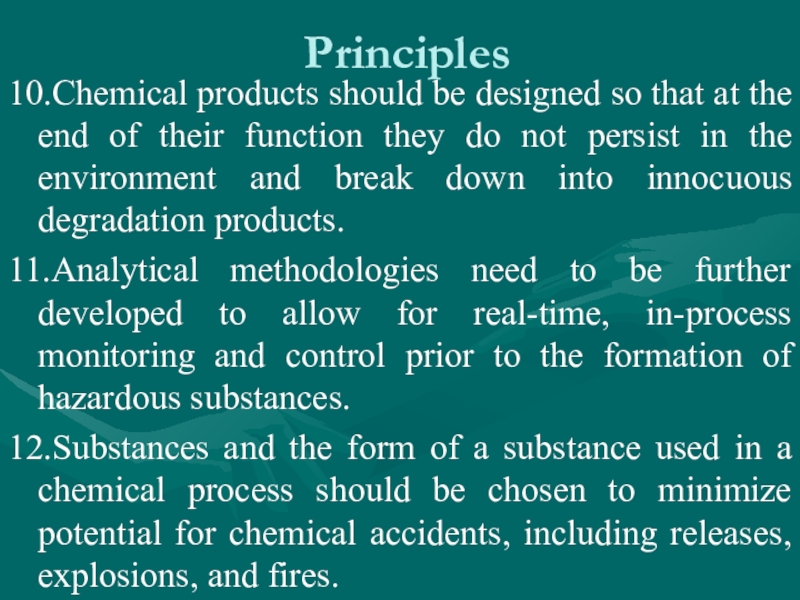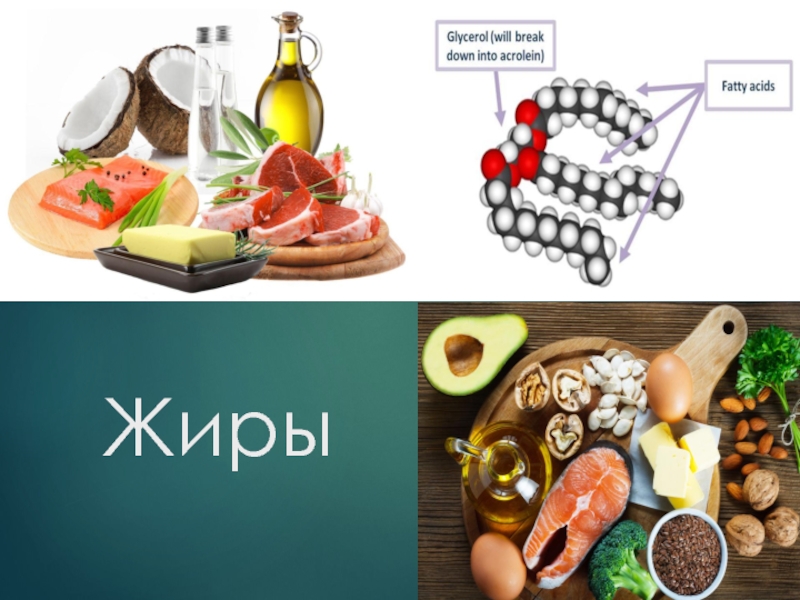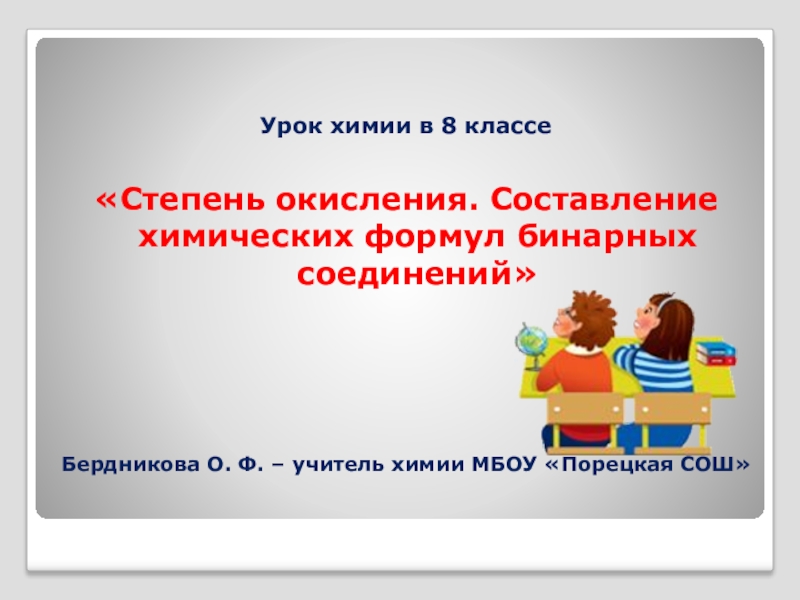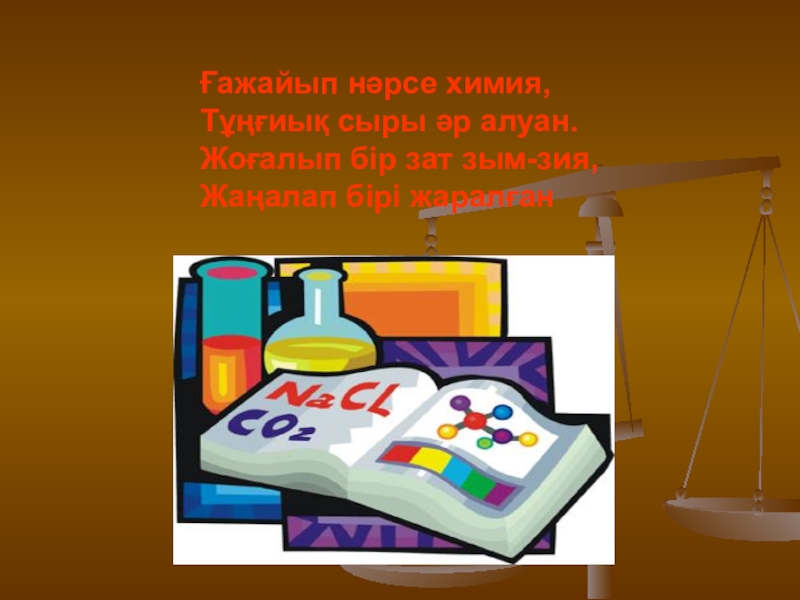- Главная
- Разное
- Образование
- Спорт
- Естествознание
- Природоведение
- Религиоведение
- Французский язык
- Черчение
- Английский язык
- Астрономия
- Алгебра
- Биология
- География
- Геометрия
- Детские презентации
- Информатика
- История
- Литература
- Математика
- Музыка
- МХК
- Немецкий язык
- ОБЖ
- Обществознание
- Окружающий мир
- Педагогика
- Русский язык
- Технология
- Физика
- Философия
- Химия
- Шаблоны, фоны, картинки для презентаций
- Экология
- Экономика
Презентация, доклад по химии для студентовПринципы зеленой химии
Содержание
- 1. Презентация по химии для студентовПринципы зеленой химии
- 2. Green chemistry Green chemistry (Green Chemistry) -
- 3. Key differences While exploring the chemistry of
- 4. The twelve principles of green chemistry are:
- 5. Principles 1.It is better to prevent waste
- 6. Principles4.Chemical products should be designed to preserve
- 7. Principles7.A raw material or feedstock should be
- 8. Principles10.Chemical products should be designed so that
- 9. Thank you for the attention
Green chemistry Green chemistry (Green Chemistry) - scientific direction in chemistry, which can be attributed any improvement of chemical processes, which positively affects the environment. As a scientific direction emerged in the 90s of XX century.
Слайд 2Green chemistry
Green chemistry (Green Chemistry) - scientific direction in chemistry,
which can be attributed any improvement of chemical processes, which positively affects the environment. As a scientific direction emerged in the 90s of XX century.
Слайд 3Key differences
While exploring the chemistry of the environment
sources, distribution, impact
resistance and chemical
contaminants; Chemistry for the Environment provides
chemical solutions to get rid of the dirt. At the same time
there are the following possible ways of making
chemicals: • 1. Dispose of pollutants released into the environment • 2. To limit their spread if they are local • 3. Stop their production - by replacing the existing methods for producing chemical products with new ones.
The first two are included in the area of research Ecological
Chemistry; last direction is an area, which is engaged in Green
Chemistry.
contaminants; Chemistry for the Environment provides
chemical solutions to get rid of the dirt. At the same time
there are the following possible ways of making
chemicals: • 1. Dispose of pollutants released into the environment • 2. To limit their spread if they are local • 3. Stop their production - by replacing the existing methods for producing chemical products with new ones.
The first two are included in the area of research Ecological
Chemistry; last direction is an area, which is engaged in Green
Chemistry.
Слайд 4The twelve principles of green chemistry are:
In 1998, PT Anastas
and
John. C. Warner, in
his book "Green
Chemistry: Theory and
Practice" formulated the
twelve principles of "green
chemistry" to guide
researchers working in this
field:
John. C. Warner, in
his book "Green
Chemistry: Theory and
Practice" formulated the
twelve principles of "green
chemistry" to guide
researchers working in this
field:
Слайд 5Principles
1.It is better to prevent waste than to treat or
clean up waste after it is formed.
2.Synthetic methods should be designed to maximize the incorporation of all materials used in the process into the final product.
3.Wherever practicable, synthetic methodologies should be designed to use and generate substances that possess little or no toxicity to human health and the environment.
2.Synthetic methods should be designed to maximize the incorporation of all materials used in the process into the final product.
3.Wherever practicable, synthetic methodologies should be designed to use and generate substances that possess little or no toxicity to human health and the environment.
Слайд 6Principles
4.Chemical products should be designed to preserve efficacy of function while
reducing toxicity
5.The use of auxiliary substances (e.g. solvents, separation agents, etc.) should be made unnecessary wherever possible and innocuous when used.
6.Energy requirements should be recognized for their environmental and economic impacts and should be minimized. Synthetic methods should be conducted at ambient temperature and pressure.
5.The use of auxiliary substances (e.g. solvents, separation agents, etc.) should be made unnecessary wherever possible and innocuous when used.
6.Energy requirements should be recognized for their environmental and economic impacts and should be minimized. Synthetic methods should be conducted at ambient temperature and pressure.
Слайд 7Principles
7.A raw material or feedstock should be renewable rather than depleting
wherever technically and economically practicable.
8.Reduce derivatives – Unnecessary derivatization (blocking group, protection/deprotection, temporary modification) should be avoided whenever possible.
9.Catalytic reagents (as selective as possible) are superior to stoichiometric reagents.
8.Reduce derivatives – Unnecessary derivatization (blocking group, protection/deprotection, temporary modification) should be avoided whenever possible.
9.Catalytic reagents (as selective as possible) are superior to stoichiometric reagents.
Слайд 8Principles
10.Chemical products should be designed so that at the end of
their function they do not persist in the environment and break down into innocuous degradation products.
11.Analytical methodologies need to be further developed to allow for real-time, in-process monitoring and control prior to the formation of hazardous substances.
12.Substances and the form of a substance used in a chemical process should be chosen to minimize potential for chemical accidents, including releases, explosions, and fires.
11.Analytical methodologies need to be further developed to allow for real-time, in-process monitoring and control prior to the formation of hazardous substances.
12.Substances and the form of a substance used in a chemical process should be chosen to minimize potential for chemical accidents, including releases, explosions, and fires.
